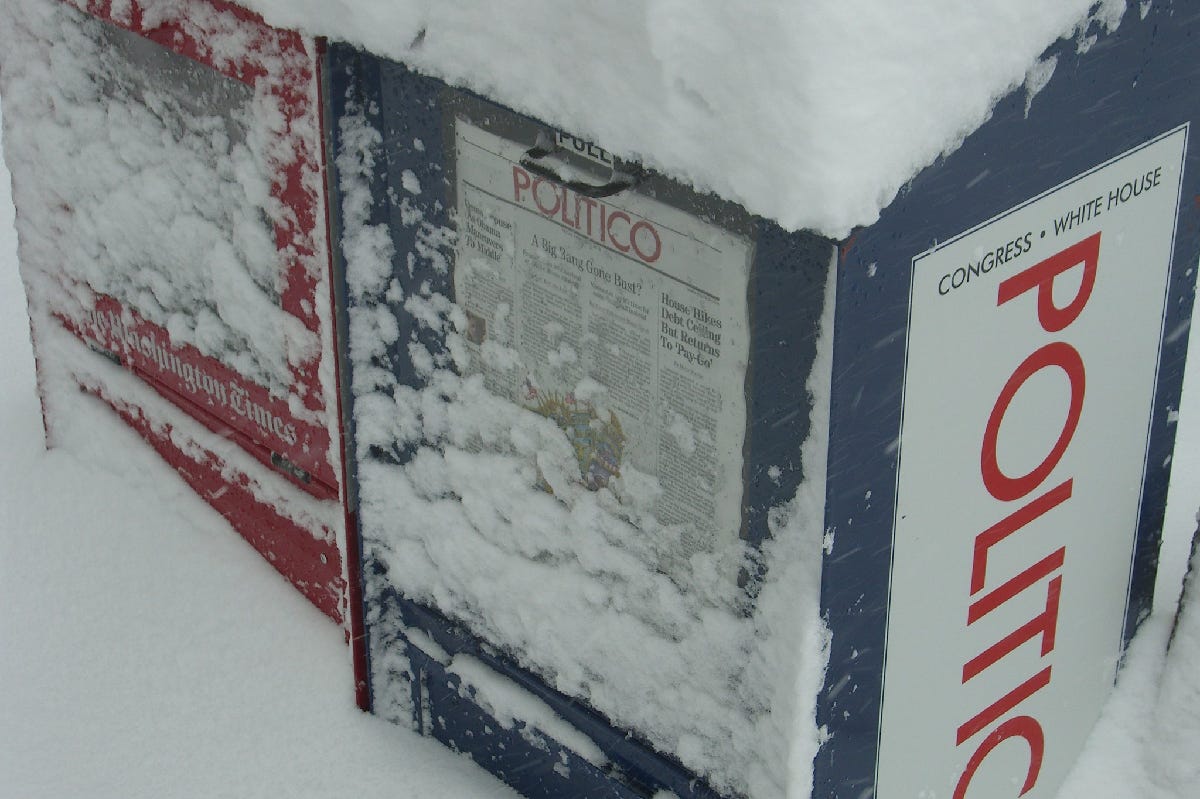How Politico kicked off the editorial newsletter renaissance
Politico Playbook was almost a decade ahead of its time.

Welcome! I'm Simon Owens and this is my media newsletter. You can subscribe by clicking on this handy little button:
Let’s jump right into it…
How Politico kicked off the editorial newsletter renaissance
When I heard earlier this week that Axel Springer had finalized its deal to buy Politico for $1 billion, one of the first things I thought of was a 2014 New York Times article by the late David Carr: “For Email Newsletters, a Death Greatly Exaggerated.”
It was among the first articles from a mainstream outlet that documented the re-emergence of editorial newsletters, the kind that are now ubiquitous across Substack, Revue, and at least a half dozen other platforms. Carr summed up the appeal of the medium thusly: “Newsletters are clicking because readers have grown tired of the endless stream of information on the Internet, and having something finite and recognizable show up in your inbox can impose order on all that chaos.”
What’s most notable about this piece is that it appeared almost exactly four years after the New York Times published another article titled “The Man the White House Wakes Up To.” It’s a long profile of Politico co-founder Mike Allen, who at the time wrote the Playbook daily newsletter. The article details Allen’s gratuitous name dropping and obsessive pursuit of “scooplets,” and we learn how he instilled a sense of FOMO among Washington influencers, most of whom opened up the email mere moments after waking up:
Playbook started [in 2007] as a chatty “what’s happening” memo that Allen sent to his Politico bosses. Eventually he started sending it to presidential-campaign officials — the first outside recipient was Howard Wolfson of Hillary Clinton’s campaign. Soon Allen would send it to non-Politico journalists, White House officials and, before long, anyone who asked. While most Playbook subscribers live around Washington, significant numbers work on Wall Street, in state capitals and at news and entertainment companies on both coasts. Major retailers (Starbucks) and obscure lobbies (Catfish Farmers of America) pay $15,000 a week to advertise in Playbook, a figure that is expected to rise.
Readers describe their allegiance with a conspicuous degree of oversharing. “I definitely read it in bed,” Katie Couric told me. “Doesn’t everybody read it in bed?” Margaret Carlson, a columnist for Bloomberg News and the Washington editor at large for The Week magazine, said in a video tribute to Allen for his 45th birthday party last June.
It’s hard to overstate how influential Playbook has been within the media industry. Prior to its launch, newsletters sent out by media outlets were little more than aggregators that linked people to online articles. Playbook, on the other hand, was entirely self contained. It included links, sure, but for the most part it’s read entirely within the inbox. What’s more, it’s imbued with an editorial voice; back in 2010 it was Mike Allen’s, today it’s run by a small team of veteran reporters.
Playbook is a journalism star maker, with several of its alumna going on to launch their own influential media outlets. It was also among the first editorial products to sell native advertising within the newsletter itself; The New York Times article quotes its rates at $15,000 a week, and the price is probably far north of that number today.
Seven years after Playbook’s launch, Carr noticed the trend it had kickstarted. Flash forward another seven years, and today every media outlet is trying to operate its own Playbook. The New York Times just launched 15 columnist-led newsletters. Quartz reoriented its entire subscription model around newsletters. And of course, not a day goes by without a high-profile writer leaving their mainstream media job to publish on Substack or some similar platform.
And now the publisher that owns Playbook is being sold for a billion dollars. I have no idea if it’s actually worth that much, but there’s no doubt that Politico has had an indelible impact on post-print media. The company’s unofficial tagline is “win the morning,” but now that it’s joined the pantheon of billion dollar media companies, it’s clear that the stakes were always much higher.
Quick hits
The Wall Street Journal wrote about “The Social-Media Stars Who Move Markets.” [WSJ] A quote from the article: "I used to spend three or four hours with one client talking to them about real estate ... that one person would turn into $10,000 dollars in revenue. Today, $10,000 in revenue is a bad day for me."
Apple is lowering the app store fees from 30% to 15% for publishers that participate in Apple News. [TechCrunch] This is pretty clever; it allows Apple to cut publishers a break on the app store fees while simultaneously enticing them onto Apple News.
Some insights into how much money a video star can make on Facebook. The payouts seem to be significantly lower than YouTube, though that observation is anecdotal. [Insider]
Forbes slapped a metered paywall onto its massive blog spam network and wants to reach 1 million digital subscribers (it currently has 23,000). If it reaches 1 million I'll eat my shoe. [Digiday]
"[Politico] recognized early on something airlines have known for a long time: It’s a lot easier to make a lot of money from a few of your customers than a little from everyone." [Nieman Lab]
10 years ago, The Washington Post and New York Times were in direct competition with each other, but now they both have vastly different priorities. [YouTube]
A good deep dive into the challenges Netflix faces as it moves into games. It's less about producing huge hits and more about providing iterative value to the bundle and reducing churn. [Matthew Ball]
Do you like this newsletter?
Then you should subscribe here:
Simon Owens is a tech and media journalist living in Washington, DC. Follow him on Twitter, Facebook, or LinkedIn. Email him at simonowens@gmail.com. For a full bio, go here.


